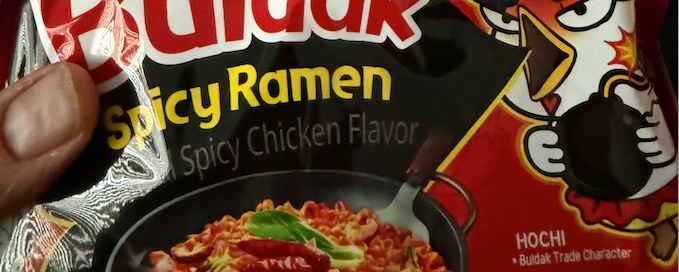This is for informational purposes only. For medical advice or diagnosis, consult a professional.
David’s Note: This article was substantially revised on October 10, 2025 to incorporate new research and provide a more comprehensive analysis.
Samyang’s Buldak ramen presents a critical public health paradox. Its viral popularity is driven by extreme spice challenges. This trend masks significant risks from dangerously high heat levels, poor nutrition, and the potential to spread illness in schools. The situation demands urgent re-evaluation by parents, educators, and public health officials.
Core Arguments
This analysis will present the following core arguments:
- Engineered for Pain, Not Palates: The extreme heat in Buldak ramen is a product of industrial food science. It is not traditional cuisine. The product uses concentrated chili extracts and an oil-based delivery system. This creates a sensory experience far more intense than its inconsistent Scoville ratings suggest. This poses a risk of acute physiological distress, especially for children.
- A Trojan Horse for Poor Nutrition: The focus on spiciness distracts from the product’s identity as an ultra-processed food. It is laden with unhealthy levels of sodium and saturated fat. These levels far exceed daily recommendations for young consumers and contribute to long-term health risks.
- From Personal Discomfort to Community Risk: The immediate physiological reactions to Buldak ramen create a tangible vector for germ transmission. This is especially true for the profuse runny nose known as gustatory rhinitis. In communal settings like schools, a personal “challenge” transforms into a community health concern.
- Counterarguments Fail to Address Key Vulnerabilities: Common defenses of the product are based on personal choice and cultural norms. These arguments do not adequately account for the product’s marketing toward vulnerable minors. They also fail to address the fundamental difference between traditional spicy foods and industrially engineered products designed for extreme consumption.
Introduction: A Global Phenomenon on Fire
A TikTok influencer is hospitalized after eating Buldak ramen weekly for six months.¹ In Denmark, a national food safety agency recalls several flavors. It cites a risk of “acute poisoning” from the extreme heat.²
This is the “Buldak Paradox.” The product’s viral success is driven by its extreme, engineered spiciness. That same attribute has brought it under the scrutiny of international public health regulators. The global instant noodle market was valued at over $61 billion in 2024.³ This single product line has become a case study in a new era of food safety challenges.
Launched in South Korea, these “fire noodles” were not propelled to fame by traditional advertising. Instead, their popularity grew from the “Fire Noodle Challenge”.⁴ This social media dare became a rite of passage for young consumers testing their endurance against the product’s formidable heat.⁵
This report argues that the Buldak phenomenon is a critical case study. It sits at the intersection of viral food culture, inconsistent product labeling, and the challenge of regulating extreme foods. This is especially true for vulnerable consumers like children. From the science of its spice to its nutritional reality, the full picture reveals a product with risks far greater than its trendy packaging suggests.
(more…)
